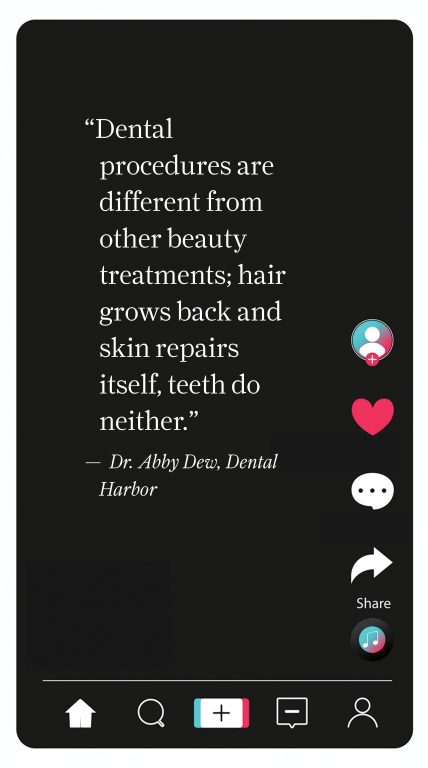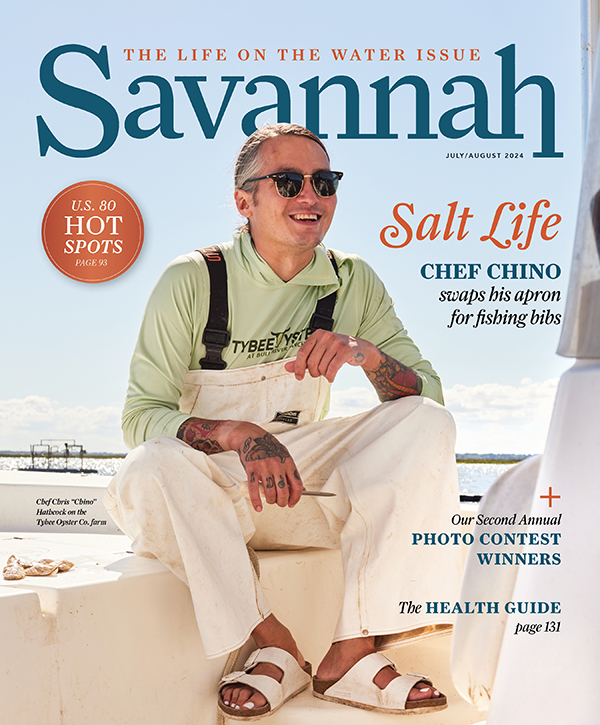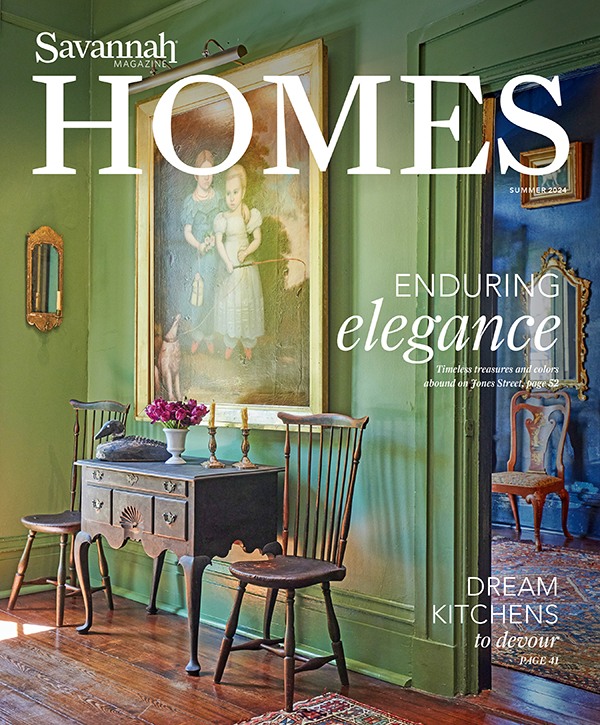Local dentists talk about the dangers of dental fads, DIY dentistry and product promotions that are spreading like wildfire on TikTok
Written by ALLISON ARBUTHNOT SANDERS
IN THE VIDEO, A PRETTY, 20-something-year-old woman wearing a black sweatshirt and a high ponytail shifts the baby on her lap to one knee as she leans forward to look closely in a small countertop mirror, her lips pulled back taunt in a dental cheek retractor.
“Come with me to do my own composite veneers!” a computer-animated voice declares as a punchy hip-hop song launches with an explicit line about being “snipped like a Barbie.” Welcome to the bizarre, resourceful, occasionally terrifying world of TikTok dentistry.
We watch as the woman uses a stainless steel pick to shape the veneer composite around her teeth, baby squirming. The video then cuts to a tight shot of her mouth, teeth and tongue glowing neon blue from a curing light. Next, she uses an electric sanding tool to straighten the edges of her top teeth.
In the final shot, the baby is gone and the sweatshirt has been replaced by a tight tank top as the woman smiles a gorgeous, brand new, gleaming white smile into the camera. She’s clearly pleased. She never showed us a “before” picture of her teeth, but her “after” looks fantastic.
• • •
So what’s the problem?
Turns out, it’s multifold, just like it is for many of the other DIY dentistry videos now trending on TikTok as the app’s content creators — known for their helpful hacks as much as their choreographed dances — turn an eye toward teeth.
TikTok dentistry videos range from DIY veneers such as the one described to a host of other at-home or budget dentistry: users filing their teeth down, rapidly moving teeth with rubber bands, mail-order alignment devices, videos promoting dental tourism (#veneersjourney) and more. But like so much of social media, things are not always what they seem.
Risks of DIY dentistry abound, and doing these “hacks,” much like doing your own veneers (or having them done by one of the many discount, unlicensed professionals now operating in Savannah, Atlanta and surrounding areas) can certainly save money up front. However, they can often end up costing much more in the long run in both pain and money.
Such was the case for several patients of Dr. Kevin Pfeiffer at Morrison Dental Associates who came to him for help.
“I recently saw a woman who had paid $600 for veneers done by an unlicensed professional,” says Pfeiffer. “They were very large, and because they hadn’t been properly equilibrated, they were hitting wrong and already chipping. There were bulky areas all along the gumline, and her gums were all red and inflamed.”

That’s not to mention the issue of unseen decay.
“You don’t always know if there is decay on your teeth, and when you put things on top of them, you’re trapping all this bacteria under there,” says Pfeiffer. “Untreated decay can spread to other teeth and lead to infection.”
This is a risk that applies to many at-home dentistry devices, from mail-order makeovers like Snap-On Smile to cosmetic accessories like tooth gems and grills. The outcomes can be truly horrifying, like it was for another patient of Pfeiffer, whose top teeth broke off at the gumline after rotting below a grill he had failed to remove and clean.
When Pfeiffer told the woman with the discount veneers that he’d have to remove them to resolve her pain, the patient initially declined. She liked them, she told him. She left, willing to roll the die on her oral health in exchange for a gleaming white, if painful, social media-worthy smile.
“The rise of social media has undeniably influenced the beauty ideals of my patients in significant ways,” says Dr. Abby Dew of Dental Harbor. “There has been a noticeable surge in interest among my younger patients when it comes to cosmetic dentistry. The constant exposure to perfectly edited images has raised the bar for beauty standards, including dental aesthetics.”
“There are so many unrealistic expectations now thanks to social media,” echoes Dr. Christy Harpring of Howard Family Dental. “People show me pictures from TikTok, saying, ‘I want my teeth to be this white.’ And I’m like, ‘That’s a filter. It’s not real.’”
Harpring says that much of the dental work she sees on social media looks “like something out of a horror movie,” even when it’s not DIY. To Harpring, “most disturbing” is the trend of influencers showing their teeth mid-treatment, where their teeth have been shaved down to slivers, which Harpring likens to “over-prepped crowns” rather than a proper veneer preparation.
“These are people who had gorgeous teeth to begin with, and now their teeth are absolutely ruined,” says Harpring. “I just cringe.”
• • •
It’s not all cringe-worthy, though.
“If we could close a gap between teeth in two days with a rubber band, don’t you think we would have been doing that the whole time?” laughs Dr. Stephanie Joy Sweeney of Savannah Dental, in response to another precarious TikTok trend. “Still, not everything they are sharing on TikTok is wrong.”
Sweeney recently recorded a series of “blind reactions” to some of viral TikTok dentistry videos for Savannah Dental’s TikTok account, telling people what’s safe and what isn’t.
“Part of why I chose to become a dentist is because I want to help people,” says. Sweeney. “I think that a lot of people who follow the TikTok dental stuff do so because they can’t afford to see a dentist, and I want to help them too.” Though she names travel dentistry as the riskiest TikTok trend, she says that the increasing awareness of DIY dentistry as a short-term solution is a positive.

“I’m all for the temporary filling kits as a temporary solution, if it’s Saturday morning and you need something to keep you together until you can get into the dentist on Monday,” says Sweeney. “I even think you should travel with that, especially if you’re in another country. But I don’t think we should think of any of these things as a long-term fix, and anything that’s irreversible I do not recommend.”
Dr. Roy Maynard of Georgetown Family Dental emphasizes the importance of keeping a short-term solution short-term, but he has seen positive sides of some dental trends on the app, as well.
“We are actually recommending oil pulling to some patients now,” says Maynard, referring to the ancient Ayurvedic practice of swishing oil (usually coconut) around the mouth like mouthwash to reduce harmful bacteria that cause gingivitis, cavities, bad breath and more that’s experiencing a surge of popularity thanks to TikTok.
Maynard says that his patients bring a healthy skepticism to the dental trends they see on social media. “My patients are fascinated by what they are seeing on TikTok. But the first question isn’t so much, ‘Is this something I can do?’ as much as, ‘Is this real?’”
It’s a question worth asking. Authenticity is a real issue in the creator economy and is especially important when creators are selling health care content.
“The monetization of social media content raises ethical concerns regarding individuals profiting from potentially harmful material,” points out Dew, who is concerned creators could prioritize views and likes over user safety. “There is also a risk that viewers may be led to believe in one-size-fits-all solutions that may not adequately address their unique dental issues, overlooking the importance of individualized care.”
• • •
For the estimated 68.5 million adults who lack dental insurance in the United States, according to the 2023 State of Oral Health Equity in America survey from CareQuest Institute, that individual care can seem elusive. There are options, though, that are much safer than DIY care.
“Dental schools are a great option for people without insurance,” suggests Pfeiffer. “In Savannah we also have a government-subsidized clinic that does income-based dentistry, J.C. Lewis, where you can get basic care like cleanings, fillings, x-rays and extractions.”
Harpring recommends the Savannah Technical College Dental Hygiene Clinic as a starting place to address issues like bleeding gums or stains, and most dental offices offer some version of a dental membership or savings plan that offers discounted services to people without insurance.
Ultimately, prioritizing dental health over cosmetic appearance will go a long way.
“Emphasizing the significance of early preventive measures such as regular brushing, flossing, and addressing minor dental issues before they escalate can significantly contribute to managing dental costs in the long run,” says Dew. And keep the mail-order and TikTok dentistry to a minimum. “Dental procedures are different from other beauty treatments; hair grows back and skin repairs itself, teeth do neither.”




